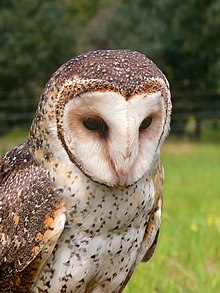Barn-owl
| Barn owls Temporal range:
Late Eocene to present | |
|---|---|

| |
| Australian masked owl ( Tyto novaehollandiae )
| |
| Scientific classification | |
| Domain: | Eukaryota |
| Kingdom: | Animalia |
| Phylum: | Chordata |
| Class: | Aves |
| Order: | Strigiformes |
| Family: | Tytonidae Ridgway, 1914 |
| Genera | |
| Synonyms | |
| |
Barn-owls (family Tytonidae) are one of the two
Barn-owls are a wide-ranging family, although they are absent from northern North America,
Five species of barn-owl are threatened, and some island species went
Taxonomy and systematics
Barn-owls consist of two extant subfamilies: the Tytoninae or Tyto owls (including the common
Extant genera
Two extant genera are recognized:[7]
- Genus Tyto – true barn-owls, grass owls and masked owls (17 species)
- Genus Phodilus – bay owls(2 species)
Genus Tyto

Some of the Tyto species that exist include the common barn owl (Tyto alba), the American barn owl (Tyto furctata), the Australian barn owl (Tyto delicatula), and the Eastern Barn Owl (T. javanica). Within each of these species, there are many subspecies. Of the common barn owl there are 10 subspecies: T. alba affinis, T. alba alba, T. alba erlangeri, T. abla ernesti, T. alba gracilirostris, T. alba guttata, T. alba hypermetra, T. alba javanica, T. alba schmitzi, and T. alba stertens. Of the American barn owl, there are 5 subspecies: T. furcata attempta, T. furcata furcata, T. furcata hellmayri, T. furcata pratincola, and T. furcata tuidara. Of the Australian barn owl, there are 4 subspecies: T. delicatula delicatula, T. delicatula interposita, T. delicatula meeki, and T. delicatula sumbaensis.[8]
The common barn owl (T. alba) can be found in Africa and parts of Asia, including Eurasia. The American barn owl (T. furcata) can be found from North to South America. Lastly, the Australian barn owl (T. delicatula) can be found in Australia, New Zealand, Polynesia, and Asia.[4]

Genus Phodilus
This genus includes the Oriental bay owls (P. badius) and the Sri Lanka bay owls (P. assimilis).[4] Bay owls have a much smaller distribution than genus Tyto, with Oriental bay owls (P. badius) found in tropical Asia and Sri Lanka bay owls (P. assimilis) found in Sri Lanka and southwestern India.[9]
Extinct genera
The
- Genus Nocturnavis (Late Eocene/Early Oligocene) – includes Bubo incertus
- Genus Necrobyas (Late Eocene/Early Oligocene – Late Miocene, France) – includes Bubo arvernensis and Paratyto
- Genus Selenornis (Late Eocene/Early Oligocene of Quercy, France) – includes Asio henrici
- Genus Prosybris (Late Eocene/Early Oligocene of Quercy(?) – Early Miocene of France and Austria)
Placement unresolved
- Tytonidae gen. et sp. indet. "TMT 164" (Middle Miocene of Grive-Saint-Alban, France) - Prosybris?
- Genus Palaeotyto (Late Eocene/Early Oligocene) from Quercy, France. Placement in this family is tentative, it may instead belong to the family Sophiornithidae.
- Genus Palaeobyas (Late Eocene/Early Oligocene) from Quercy, France. Placement in this family is tentative, it may instead belong to the family Sophiornithidae.
Former genera
The supposed "giant barn-owl"
Description
The barn-owl's main characteristic is the heart-shaped facial disc, formed by stiff feathers which serve to amplify and locate the source of sounds when hunting.[13] Further adaptations in the wing feathers eliminate sound caused by flying, aiding both the hearing of the owl listening for hidden prey and keeping the prey unaware of the owl. Barn-owls overall are darker on the back than the front, usually an orange-brown colour, the front being a paler version of the back or mottled, although considerable variation is seen even within species.
Bay owls closely resemble the Tyto owls, but have a divided facial disc, ear tufts, and tend to be smaller.
References
- ISBN 8487334253
- ISSN 0167-8809.
- ^ Marcot, Bruce G. (1995). "Owls of Old Forests of the World" (PDF). United States Department of Agriculture - Forest Service. p. 26. Retrieved 6 March 2019.
- ^ PMID 29535030.
- ^ Wetmore, Alexander (October 1937). "Bird Remains from Cave Deposits on Great Exuma Island in the Bahamas". Bulletin of the Museum of Comparative Zoology at Harvard College. 80 (12): 425–428.
- ^ Arredondo, O (1972). "Especie nueva de lechuza gigante (Strigiformes: Tytonidae) del Pleistoceno cubano" (PDF). Boletín de la Sociedad Venezolana de Ciencias Naturales (in Spanish).
- ^ Gill, Frank; Donsker, David, eds. (2017). "Owls". World Bird List Version 7.3. International Ornithologists' Union. Retrieved 28 August 2017.
- OCLC 639518017.
- OCLC 890655208.
- ^ Mourer-Chauviré, Cécile (December 2001). "The systematic position of the genus Basityto, Mlikovsky 1998" (PDF). Proceedings of the Biological Society of Washington. 114 (4): 964–971.
- ISBN 0-226-77142-3.
- – via SORA.
- LCCN 76009298.
External links
- Barn owls on the Internet Bird Collection
